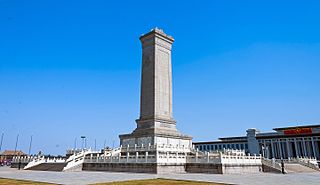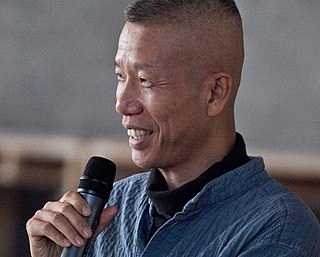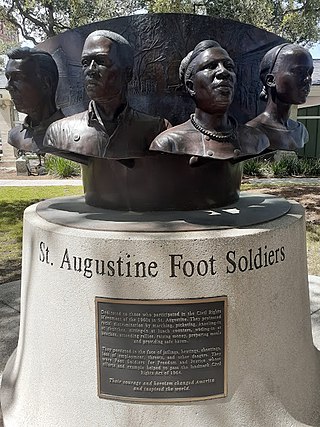 | |
| Location | Shanghai, China |
|---|---|
The May Thirtieth Movement Monument is an outdoor sculpture and memorial commemorating to the May Thirtieth movement, installed at People's Park in Shanghai, China.
 | |
| Location | Shanghai, China |
|---|---|
The May Thirtieth Movement Monument is an outdoor sculpture and memorial commemorating to the May Thirtieth movement, installed at People's Park in Shanghai, China.

The steel sculpture was installed just south of Nanjing Road in the 1990s. It depicts a flame and the two characters for 五 and 卅. Behind the sculpture is a bas relief explaining, in Chinese, the events that took place in 1925. [1]
In 2008, Shanghaiist wrote, "we wouldn't recommend it. The city's homeless population apparently fails to grasp the monument's historical richness and instead tend to use its relative seclusion to literally take a piss on their shared heritage. But, in the spirit of the monument, it's kind of fitting the way underclasses are making their voices heard. Power to the people, right on." [1]

Shanghai is a direct-administered municipality and the most populous urban area in China. The city is located on the Chinese shoreline on the southern estuary of the Yangtze River, with the Huangpu River flowing through it. The population of the city proper is the third largest in the world, with around 24.87 million inhabitants in 2023, while the urban area is the most populous in China, with 29.87 million residents. As of 2022, the Greater Shanghai metropolitan area was estimated to produce a gross metropolitan product (nominal) of nearly 13 trillion RMB. Shanghai is one of the world's major centers for finance, business and economics, research, science and technology, manufacturing, transportation, tourism, and culture. The Port of Shanghai is the world's busiest container port.

Charging Bull, sometimes referred to as the Bull of Wall Street or the Bowling Green Bull, is a bronze sculpture that stands on Broadway just north of Bowling Green in the Financial District of Manhattan in New York City. The 7,100-pound (3,200 kg) bronze sculpture, standing 11 feet (3.4 m) tall and measuring 16 feet (4.9 m) long, depicts a bull, the symbol of financial optimism and prosperity. Charging Bull is a popular tourist destination that draws thousands of people a day, symbolizing Wall Street and the Financial District.

The Monument to the People's Heroes is a ten-story obelisk that was erected as a national monument of China to the martyrs of revolutionary struggle during the 19th and 20th centuries. It is located in the southern part of Tiananmen Square in Beijing, in front of the Mausoleum of Mao Zedong. The obelisk monument was built in accordance with a resolution of the First Plenary Session of the Chinese People's Political Consultative Conference (CPPCC) adopted on November 30, 1949, with construction lasting from August 1952 to May 1958. The architect of the monument was Liang Sicheng, with some elements designed by his wife, Lin Huiyin. The civil engineer, Chen Zhide (陈志德) was also instrumental in realizing the final product.

Shanghai railway station is one of the four major railway stations in Shanghai, China, the others being Shanghai South, Shanghai Hongqiao, and Shanghai West (Shanghaixi).

The May Thirtieth Movement was a major labor and anti-imperialist movement during the middle-period of the Republic of China era. It began when the Shanghai Municipal Police opened fire on Chinese protesters in Shanghai's International Settlement on 30 May 1925. The shootings sparked international censure and nationwide anti-foreign demonstrations and riots such as the Hands Off China protests in the United Kingdom.

Cai Guo-Qiang is a Chinese artist.
Niv Horesh is a researcher formerly at Western Sydney University, Australia. He was also visiting professor in China Studies at the School of Government and International Affairs at Durham University, United Kingdom. Besides his academic work, he was also a frequent commentator on current affairs in newspapers such as the South China Morning Post and Haaretz.
Portrait of History, a public sculpture by Chinese American artists Zhou Brothers, is located on the Indiana University-Purdue University Indianapolis campus, which is near downtown Indianapolis, Indiana. The sculpture is located at the Blackford Street entrance to the Herron School of Art and Design. This piece is one of four public artworks on loan from the Indianapolis Museum of Art to IUPUI. The artworks were moved to the campus on March 22, 2009. Portrait of History is a bronze sculpture measuring 100 x 24 x 30 in and is mounted on an oval cement base.
Meridians Shanghai 2010: Art & Sound in Public Space Project (Meridians) was an international collaboration between RMIT University (RMIT), Melbourne, Australia and East China Normal University (ECNU), Shanghai, China to create an installation of urban contemporary public artworks in Shanghai, China for the official Victorian Cultural Program towards Australia's contribution to Expo 2010 Shanghai China.

St. Augustine Foot Soldiers Monument is located near the corner of King St. and Charlotte St. in the Southeast corner of the Plaza de la Constitución, a historic public park in downtown St. Augustine, Florida. It is in remembrance of the people who engaged in various forms of peaceful protest in St. Augustine in the early 1960s to advance the cause of civil rights, contributing to the passage of the Civil Rights Act of 1964. The monument, commissioned by the St. Augustine Foot Soldiers Remembrance Project, Inc., was installed and unveiled in May, 2011.
Three Heads Six Arms is a sculpture by Chinese artist Zhang Huan. The work, composed of copper and steel, is 27 feet (8.2 m) tall and weighs 15 short tons (14 t). From May 2010 to February 2011, the sculpture was installed at the Joseph L. Alioto Performing Arts Piazza in San Francisco's Civic Center, before moving to Hong Kong later that year from May to July. A slightly modified version was exhibited in Florence in 2013.

People's Park is a public park in Huangpu District of central Shanghai. It is located south of Nanjing Road, a major shopping street, and north of People's Square. Originally the northern part of the Shanghai Race Club's race course, the park was created in 1952. With several major museums and Shanghai's main shopping street nearby, it is one of the top tourist destinations in the city.

Liu Shaoqi was a Chinese revolutionary and politician. He was the chairman of the Standing Committee of the National People's Congress from 1954 to 1959, first-ranking vice chairman of the Chinese Communist Party from 1956 to 1966, and the chairman of the People's Republic of China, the head of state from 1959 to 1968. He was considered to be a possible successor to Mao Zedong, but was purged during the Cultural Revolution.

Hehe Xiexie, or Hehe, Xiexie, is an outdoor 2009–2010 sculpture created by Zhang Huan as part of Art for the World, a collection of twenty monumental sculptures along the Expo Axis organised by Jean-Gabriel Mitterrand, for Expo 2010. It is still installed at Expo Boulevard in Shanghai, China.

A bronze sculpture of Tomáš Garrigue Masaryk is installed at Prague Castle in Prague, Czech Republic.

Li Qiang was a Chinese Communist revolutionary, military engineer, secret agent, radio scientist, diplomat, and politician. He served as the 2nd Minister of Foreign Trade of China from November 1973 to September 1981, and was elected an academician of the Chinese Academy of Sciences in 1955.

The tomb of Lu Xun is the burial place of the Chinese writer Lu Xun (1881–1936), located in the northwestern corner of the Lu Xun Park in Hongkou District, Shanghai. Covering an area of 1,600 square metres (17,000 sq ft), the tomb of Lu Xun was built in 1956, and in the same year, the remains of Lu Xun was moved to this tomb from the Wanguo Cemetery of Shanghai.

An equestrian statue of George Washington by Thomas Ball is installed in Boston's Public Garden, in the U.S. state of Massachusetts.

The Hungarian Revolution Memorial is a monument and sculpture by E. Gyuri Hollosy, installed in Boston's Liberty Square Park, in the U.S. state of Massachusetts. It commemorates the thirtieth anniversary of the Hungarian Revolution of 1956.

Portrait Monument is a 1920 marble sculpture by Adelaide Johnson, installed in the U.S. Capitol's rotunda, in Washington, D.C. The artwork was dedicated in 1921 and features portrait busts of Elizabeth Cady Stanton, Susan B. Anthony, and Lucretia Mott.